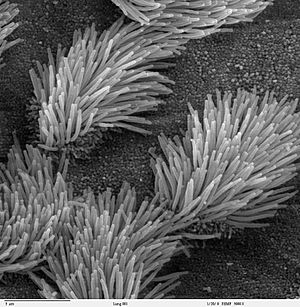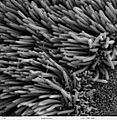Cilia facts for kids
A cilium (say: SILL-ee-um) is a tiny, hair-like part found on the outside of many cells. Think of them as tiny fingers sticking out from a cell. They are so small you need a powerful microscope to see them!
Cilia are important for many jobs in living things. There are two main kinds:
- Motile cilia are like tiny oars. They can move and beat back and forth. This movement helps push fluids or other things around.
- Non-motile or primary cilia usually don't move. Instead, they act like tiny antennas or sensors. They help cells feel and react to their surroundings.
Cilia are very similar to another cell part called a flagellum (say: fla-JELL-um). Flagella are usually longer and fewer in number, but they are built in a similar way. Both cilia and flagella help cells move or sense things.
Contents
What Do Cilia Do?
Cilia have many important roles in living things.
Motile Cilia in Action
Motile cilia are like tiny brooms or propellers.
- In tiny, one-celled creatures called protists, like the Paramecium, motile cilia help them swim around in water.
- In your body, motile cilia are found in places like your lungs and digestive system. In your lungs, they work hard to sweep out dust, germs, and mucus, keeping your airways clean.
Non-Motile Cilia as Sensors
Non-motile cilia are like tiny sensors that help cells detect different signals.
- Most cells in your body actually have one of these non-moving cilia!
- In your eyes, special non-motile cilia help you see light. They are part of the cells that detect light.
- In your nose, non-motile cilia are found on cells that help you smell. They have special parts that can recognize different smells.
Cilia and Other Cell Parts
Cilia, along with flagella, are special parts of a cell called organelles. Organelles are like tiny organs within a cell, each with a specific job. Other organelles you might know are mitochondria, which make energy for the cell. Scientists are always learning more about how these tiny parts work together to make living things function.
Images for kids
See also
 In Spanish: Cilio para niños
In Spanish: Cilio para niños




